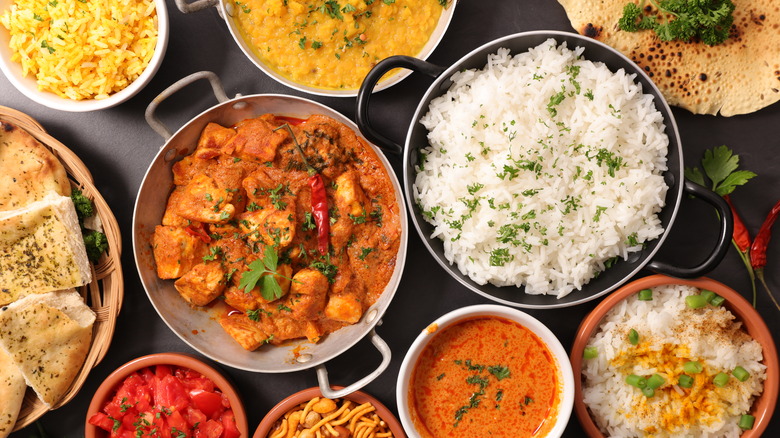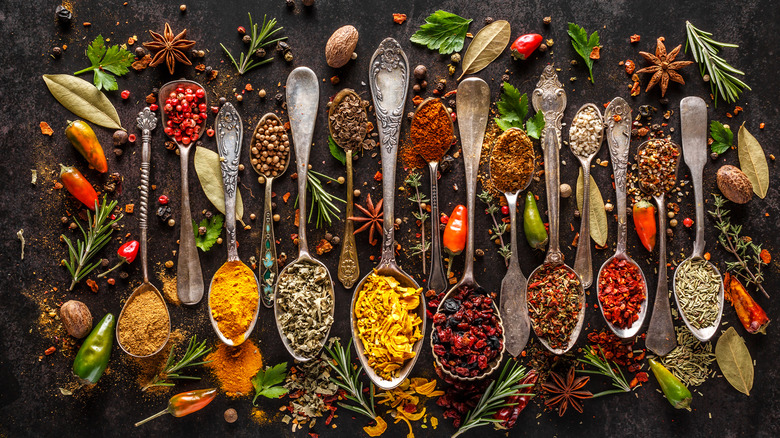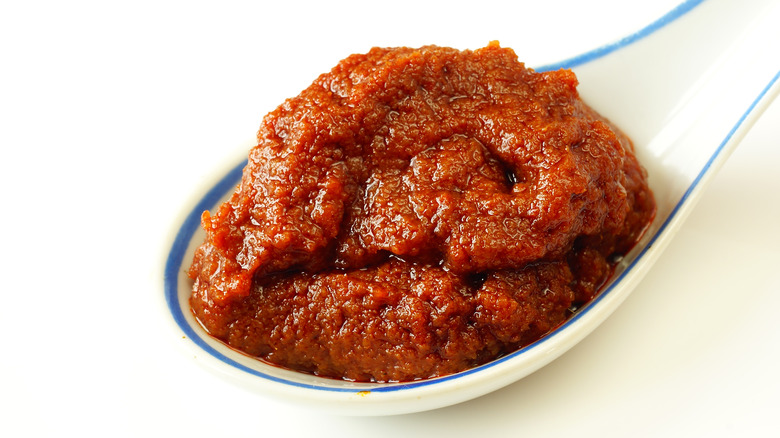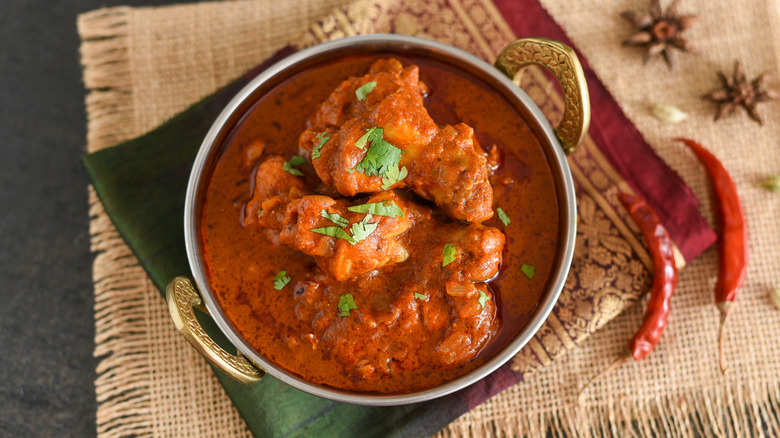What Is The Difference Between Curry Powder And Curry Paste?
You've heard of curry before, right? Of course, you have! It is one of the world's best comfort foods. No, seriously, it really is. Whether it is Thai chicken curry, veggie coconut curry, green curry, or paneer tikka masala, the warm, toasty liquid-based dish is sure to give chicken noodle soup a run for its money as the ultimate sick-day dish. Do you want to know why? It's because of all those delicious yet healthy spices! Curries are known for their spectacular flavor, but the spices used — like turmeric, ginger, fenugreek, and garlic — also pack a lot of health benefits (via Healthline).
Curry dishes are quite commonplace now, and while the word "curry" might bring to mind the sights and smells of a brightly colored, steaming, stew-like dish sitting next to a bowl of rice, Bon Appétit tells us we are thinking of curries all wrong. "Curry" doesn't refer to a meat or veggie saucy recipe; "curry" refers to an intense combination of spices mixed into various dishes. These spices can vary greatly, and come in all kinds of different combinations and forms, some of which are powder, others which are paste, and all of which are incredibly delicious.
What is curry powder?
If you're the kind of person with an entire drawer or cabinet dedicated to spices, odds are that you've got a bare minimum of one or two curry powder mixes. Packed with nuanced flavors and often brightly colored, curry powder should be a household essential. But, if you've lived a plain-food life thus far and are just awakening to the magic world of herbs and spices, here's what you need to know. MyRecipes explains that curry powder is quite diverse. In fact, "curry" simply is understood as a blend of spices that can be used in any number of dishes. Curry powder is not as basic as pouring three kinds of spices together and calling it a day; instead, the powder recipes can use upward of 20 various herbs and spices, creating a unique and complex-tasting blend of flavors. Many individuals make their own well-beloved curry powders at home using a combination of ingredients like turmeric, cumin, coriander, sesame seeds, saffron, nutmeg, fennel, cloves, chilis, tamarind, cinnamon, cardamom, etc. to flavor their recipes any way they like.
According to Epicurious, curry powder is used globally and in different ways, depending on what country they are in. Some cuisines call for it in stews, while others prefer it as a meat rub; but, because there are so many different kinds of curry powders, all tasting quite different from one another and highlighting different flavors, some spice mixes work best on specific dishes.
What is curry paste?
After reading about curry powder, you probably have a good grasp of what curry paste is: mixed spices in a thickened form. Webstaurant Store describes curry paste as using the same concept of curry powder (using a large number of spices and herbs to create a powerfully flavored dish) and then mashing that spice mix with chili peppers and galangal. Galangal is a plant in the ginger family carrying much of the same flavor profile and is considered to be beneficial in medical and culinary endeavors (via Healthy Hildegard). Curry paste is less common than curry powder, but it packs the same punch and is as brightly colored, though it is mostly used in Thai cuisine.
Allrecipes says that to use curry paste in a curry, you must add the paste directly onto a warm skillet with the recipe's other ingredients, such as meats or vegetables, to cook together. Only after the flavor is fully infused into the ingredients is a liquid added to the curry. Curry paste is powerful and will carry through any broth or milk used in the dish and will shine when served with a bowl of rice. You can also use curry paste in other dishes as a rub or marinade, or it can even be used as a secret ingredient for some truly delicious salad dressing. Curry paste is just as versatile in flavor and character as curry powder, so there are a lot of options to choose from.
Can you swap one for the other?
Now, even though curry powder and paste are indeed for the same purpose — providing deep flavor to a recipe — you shouldn't replace one with the other in your dishes all willy-nilly. They are not the same thing and therefore they will not have quite the same outcomes. According to Fine Dining Lovers, the primary ingredients in curry powder are turmeric, dried yellow mustard, coriander, ginger, white pepper, cumin, cardamom, and ginger and the powder itself must be cooked. Curry paste, on the other hand, is far more pungent and uses extra spices (chili and galangal) for color and power. So, if you were to replace curry powder with equal parts curry paste, you'd end up with a much more intensely flavored dish than you anticipated.
Blue Apron tells us that these different curry ingredients have different flavor characteristics but should also be used differently. The site says that curry paste must be thoroughly mixed into a liquid base while cooking; however, curry powder must be cooked or infused in oil before being added to the recipe. Why? Well, the spices need to bloom fully before being added to food, or else you won't taste the full effect of their flavor. Additionally, curry powder is most commonly used in Indian cuisine while the paste is traditionally used in Thai food.



